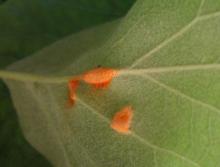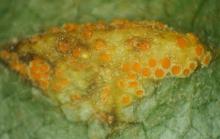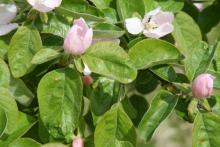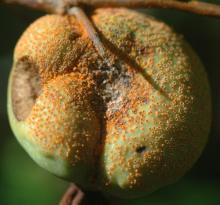See:
Hawthorn (Crataegus spp.) - Rusts
Cause Several fungi in the genus Gymnosporangium cause rusts on quince. G. clavariiforme (alternate host juniper) and G. libocedri (alternate host incense-cedar) have been reported from Oregon; from Washington, G. clavipes (alternate host cedar and juniper). The rusts occur throughout North America wherever perennial hosts (mainly juniper) grow near the deciduous hosts (members of the rose family, including hawthorn, Amelanchier, cotoneaster, apple, pear, hawthorn, quince, and Sorbus). Quince rust can cause serious crop loss on susceptible European quince cultivars due to premature defoliation and reduction in fruit quality. Spores that form on quince are usually shed in mid- to late summer and infect juniper. Juniper galls release orange spores in spring, which are blown to nearby quince and other hosts. These spores infect newly opening leaves and tender young fruit. Spore stages produced on the junipers or cedars infect only quince and members of the rose family in early spring but can be produced repeatedly over 2 to 3 years from one infection.
Symptoms Yellow-orange lesions appear on leaves, twigs, and/or fruit in late spring. Leaf lesions turn brown and fall out creating holes in the leaves. Juniper infections usually appear as swellings or galls on twigs and produce orange spores in spring.
Cultural control
- Check the vicinity for infected juniper; if they have no value, remove them.
- If you are growing both hosts as crops, separate them as widely as possible. Separating hosts by 0.5 to 2 miles has been recommended.
- Prune out any visible galls or swellings on juniper before spring and remove visible infections on hawthorn or other deciduous hosts before they sporulate in summer.
Chemical control Protect new growth when infections on juniper are sporulating in spring, sometime between mid-March and mid-May depending on weather and location.
- Aprovia at 5.5 to 7 fl oz/A plus another fungicide and an adjuvant. Do not use within 30 days of harvest. Group 7 fungicide. 12-hr reentry.
- Cueva at 1 to 2 gal/A. May be used on day of harvest. Group M1 fungicide. 4-hr reentry. O
- Flint Extra at 2.5 to 2.9 fl oz/A. Use on a protectant schedule and not curatively. Do not use within 14 days of harvest. Injury may occur to Concord grapes if accidentally sprayed. Group 11 fungicide. 12-hr reentry.
- Fontelis at 16 to 20 fl oz/A. Do not use within 28 days of harvest. Group 7 fungicide. 12-hr reentry.
- Inspire Super at 12 fl oz/A. Do not apply within 14 days of harvest. Group 3 + 9 fungicide. 12-hr reentry.
- Luna Sensation at 4 to 5.8 fl oz/A. Do not use within 14 day of harvest. Group 7 + 11 fungicide. 12-hr reentry.
- Mancozeb (such as Dithane, Manzate, or Penncozeb) up to 6 lb/A prebloom or at 3 lb/A after bloom. Do not combine the 6 lb/A prebloom or the 3 lb/A all-season schedules. Do not apply within 77 days of harvest. See label restrictions. Group M3 fungicides. 24-hr reentry.
- Miravis at 3.4 fl oz/A. Do not use within 30 days of harvest. Group 7 fungicide. 12-hr reentry.
- Rhyme at 4 to 6 fl oz/A. Do not use within 14 days of harvest. Group 3 fungicide. 12-hr reentry.
- Tebucon 45 DF at 4 to 8 oz/A. Do not use within 75 days of harvest. Group 3 fungicides. 5-day reentry.
- Topguard SC at 13 fl oz/A. Do not use within 14 days of harvest. Group 3 fungicide. 12-hr reentry.
Note Some registered products offer only suppression of this disease and thus are not recommended for use. These products include Cevya, Merivon, Pristine, Sovran and Tesaris.





